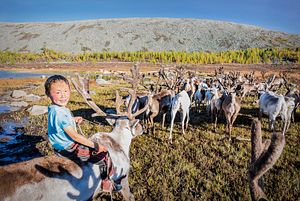Tsaatan literally means “reindeer people” and actually there could not be a more appropriate term to describe one of the least numerous ethnic minorities in Mongolia. Approximate 200 members of this tribe remain today. Inhabiting the mountains of the northernmost region of Mongolia, they focus their entire culture around their reindeer, moving seven times a year to comply with the animals’ specific dietary needs.
Tsaatan society is divided into the East and West Taiga. Eastern Tsaatan mostly live and move together as a clan, forming camps, whereas families from the West Taiga practice a more independent lifestyle. Whilst men work as reindeer herders from childhood, women work at their Ortz (traditional Tsaatan homes) to prepare any culinary product that can be produced out of this animal, such as milk, butter, yogurt, cheese, or meat. Pine nuts and wild berries complete their basic nourishment.
In 2012, the region where Tsaatan live was declared as a national park, introducing a ban on all hunting and strict restrictions on the areas where they traditionally camp. Those new regulations are demanding an effort to adapt and preserve a lifestyle that requires surviving -40ºC winters and living at altitudes of over 2,000 meters above sea level (masl) in order to be able to continue with their main labor of love: taking care of their reindeer.
Miguel Cano is a filmmaker, a photographer and the director of Mr. Challenge films: www.mrchallengefilms.













































